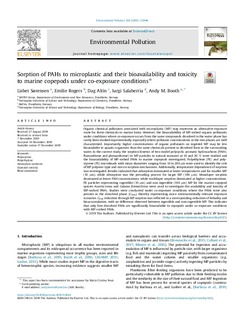| dc.contributor.author | Sørensen, Lisbet | |
| dc.contributor.author | Rogers, Emilie | |
| dc.contributor.author | Altin, Dag | |
| dc.contributor.author | Salaberria, Iurgi | |
| dc.contributor.author | Booth, Andy | |
| dc.date.accessioned | 2020-02-17T15:14:12Z | |
| dc.date.available | 2020-02-17T15:14:12Z | |
| dc.date.created | 2019-12-16T16:23:29Z | |
| dc.date.issued | 2020-03 | |
| dc.identifier.issn | 0269-7491 | |
| dc.identifier.uri | http://hdl.handle.net/11250/2642078 | |
| dc.description.abstract | Organic chemical pollutants associated with microplastic (MP) may represent an alternative exposure route for these chemicals to marine biota. However, the bioavailability of MP-sorbed organic pollutants under conditions where co-exposure occurs from the same compounds dissolved in the water phase has rarely been studied experimentally, especially where pollutant concentrations in the two phases are well characterized. Importantly, higher concentrations of organic pollutants on ingested MP may be less bioavailable to aquatic organisms than the same chemicals present in dissolved form in the surrounding water. In the current study, the sorption kinetics of two model polycyclic aromatic hydrocarbons (PAHs; fluoranthene and phenanthrene) to MP particles in natural seawater at 10 and 20 °C were studied and the bioavailability of MP-sorbed PAHs to marine copepods investigated. Polyethylene (PE) and polystyrene (PS) microbeads with mean diameters ranging from 10-200 µm were used to identify the role of MP polymer type and size on sorption mechanisms. Additionally, temperature dependence of sorption was investigated. Results indicated that adsorption dominated at lower temperatures and for smaller MP (10 µm), while absorption was the prevailing process for larger MP (100 µm). Monolayer sorption dominated at lower PAH concentrations, while multilayer sorption dominated at higher concentrations. PE particles representing ingestible (10 µm) and non-ingestible (100 µm) MP for the marine copepod species Acartia tonsa and Calanus finmarchicus were used to investigate the availability and toxicity of MP-sorbed PAHs. Studies were conducted under co-exposure conditions where the PAHs were also present in the dissolved phase (Cfree), thereby representing more environmentally relevant exposure scenarios. Cfree reduction through MP sorption was reflected in a corresponding reduction of lethality and bioaccumulation, with no difference observed between ingestible and non-ingestible MP. This indicates that only free dissolved PAHs are significantly bioavailable to copepods under co-exposure conditions with MP-sorbed PAHs. | nb_NO |
| dc.language.iso | eng | nb_NO |
| dc.publisher | Elsevier Ltd | nb_NO |
| dc.rights | Navngivelse 4.0 Internasjonal | * |
| dc.rights.uri | http://creativecommons.org/licenses/by/4.0/deed.no | * |
| dc.subject | Polystyrene | nb_NO |
| dc.subject | Polyethylene | nb_NO |
| dc.subject | Adsorption isotherm | nb_NO |
| dc.subject | Copepod toxicity | nb_NO |
| dc.subject | Bioaccumulation | nb_NO |
| dc.title | Sorption of PAHs to microplastic and their bioavailability and toxicity to marine copepods under co-exposure conditions | nb_NO |
| dc.type | Journal article | nb_NO |
| dc.type | Peer reviewed | nb_NO |
| dc.description.version | publishedVersion | nb_NO |
| dc.rights.holder | © 2019 The Authors. Published by Elsevier Ltd. | nb_NO |
| dc.source.journal | Environmental Pollution | nb_NO |
| dc.identifier.doi | 10.1016/j.envpol.2019.113844 | |
| dc.identifier.cristin | 1761473 | |
| dc.relation.project | Norges forskningsråd: 257479 | nb_NO |
| dc.relation.project | Norges forskningsråd: 268404 | nb_NO |
| cristin.unitcode | 7566,6,0,0 | |
| cristin.unitname | Miljø og nye ressurser | |
| cristin.ispublished | false | |
| cristin.fulltext | original | |
| cristin.qualitycode | 1 | |

